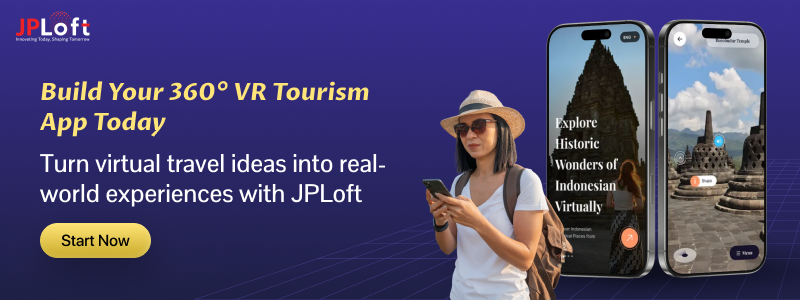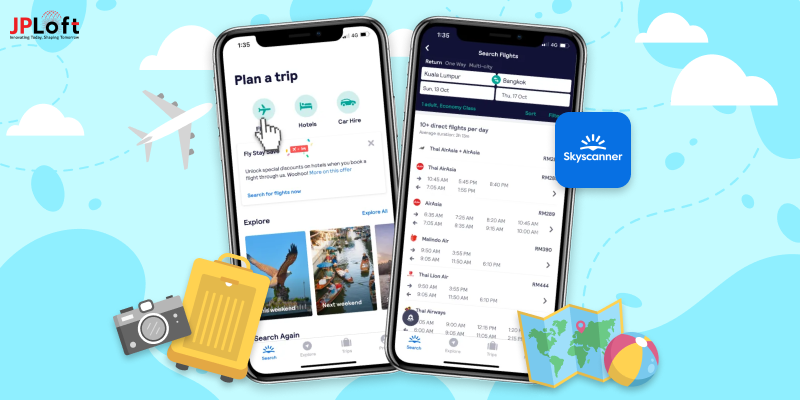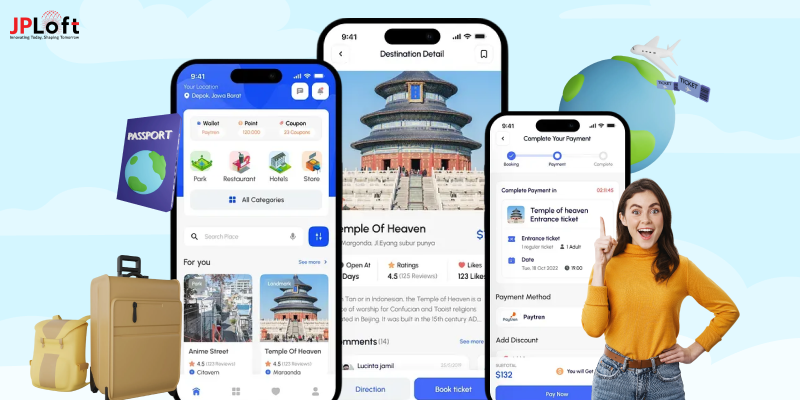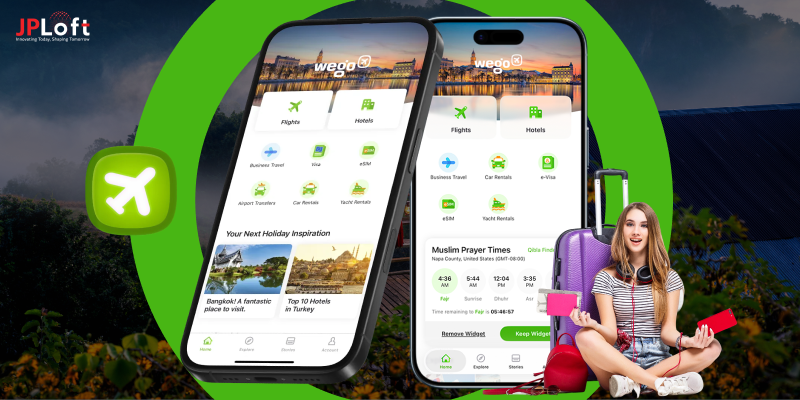Key Takeaways
360 VR apps for tourism are revolutionizing how travelers explore destinations by offering immersive, real-time virtual experiences that inspire real-world journeys.
The rising popularity of VR in tourism apps in 2026 highlights how technology is reshaping the global travel industry with more personalized, engaging, and sustainable experiences.
To build a VR for tourism in simple steps, focus on creating 3D or 360° immersive content, integrating AI personalization, and ensuring cross-device compatibility for seamless exploration.
Successful VR tourism apps combine innovation, user-centric design, and robust testing to deliver smooth, memorable, and high-performing travel experiences.
Partnering with JPLoft empowers you to create a VR app for tourism through expert-driven development, innovation, and strategic execution.
Tourism is stepping into a new dimension in 2026, quite literally, with the power of immersive technology.
The blend of 360-degree visuals and Virtual Reality for Tourism is transforming how travelers explore destinations before they even pack their bags. From virtual hotel walkthroughs to lifelike cultural tours, travelers can now experience the world in vivid realism from their screens.
So, how to develop a 360 VR app for tourism?
You can make a 360VR app for tourism by combining 360° video capture, interactive 3D environments, and real-time navigation powered by VR technology, all designed to offer travelers an immersive pre-visit experience.
This blog explores what these apps are, why they’re booming, and how you can create a VR app for tourism that redefines travel engagement in 2026.
What is a 360 VR App for Tourism?
A 360 VR app for tourism is an immersive digital platform that allows travelers to virtually explore destinations through 360° visuals and interactive VR environments.
Unlike conventional travel apps that display static photos or videos, these apps deliver a “try before you travel” experience, helping users explore landmarks, hotels, and attractions from anywhere.
For businesses and startups learning how to create a travel app, integrating VR technology can dramatically elevate engagement and conversion rates. These apps empower users to make confident travel decisions while enabling brands to showcase destinations through lifelike digital storytelling.
Key Market Insights (2026):
-
The global VR tourism market is projected to exceed $25 billion by 2026, driven by advancements in AI, 5G, and immersive rendering.
-
Nearly 45% of Gen Z travelers prefer exploring destinations in VR before finalizing trip plans.
-
VR-based travel marketing boosts booking intent by up to 85% compared to static visuals.
-
Adoption of VR tourism experiences by travel brands has surged 60% year-over-year, reflecting the growing demand for immersive exploration.
As technology evolves, understanding the cost to develop a travel app with integrated 360° VR features becomes essential for businesses aiming to stay competitive.
While development costs depend on factors like 3D model complexity, rendering quality, and device optimization, the investment offers exceptional ROI through deeper engagement, higher bookings, and stronger brand loyalty.
In essence, 360 VR tourism apps are redefining travel by merging imagination with realism, offering travelers a virtual passport to the world and helping tourism brands create unforgettable pre-travel experiences.
Why Virtual Reality Apps Have Become Famous in 2026?
Virtual Reality (VR) has evolved from a futuristic concept into a travel industry essential. In 2026, its blend of immersive storytelling, AI-powered personalization, and real-time interactivity has made it indispensable for tourism businesses.
Travelers now don’t just view destinations, they experience them through virtual reality for tourism platforms before making their final plans.
1. Rise of Immersive Digital Travel Experiences
Modern travelers seek authentic experiences, not just visuals. A VR in tourism app enables users to explore destinations in full 360° immersion.
From mountain trails to luxury resorts, VR bridges the gap between curiosity and decision-making, redefining how developers approach 360 VR app creation for tourism and enhancing user interactivity.
2. Influence of AI and Automation
AI, ML, and NLP have made virtual reality integration for travel & tourism more intelligent and intuitive. Within VR apps, AI-driven assistants personalize travel journeys, recommend destinations, and deliver real-time guidance.
This innovation reflects the growing impact of AI in hospitality, where automation elevates guest experiences and improves service efficiency across hotels and tour ecosystems.
3. Enhanced Marketing and Conversion Power
Travel brands now use VR as a dynamic storytelling and marketing tool. Immersive hotel tours, city previews, and adventure demos engage users emotionally, driving higher conversions.
As travelers virtually “try before they buy,” brands benefit from stronger trust and faster booking decisions.
4. Cost-Effective Engagement for Brands
VR technology has become affordable for startups and mid-sized businesses. With modular 3D tools and cloud rendering, even smaller brands can craft immersive experiences efficiently.
Studying how to create an app like Hopper offers insight into designing visually engaging, cost-optimized travel apps that inspire user engagement without overshooting budgets.
5. Consumer Demand for Tech-Led Exploration
Today’s audience expects personalization, immersion, and control, three aspects VR delivers seamlessly.
Travelers increasingly prefer exploring destinations virtually before booking real experiences, proving how virtual reality in tourism has evolved from luxury to necessity in the modern travel landscape.
Reasons to Invest in a 360 VR App for Tourism
The travel industry has entered an era where virtual reality for tourism is no longer optional; it’s a game-changing differentiator.
As travelers seek immersive digital previews before booking, investing in a 360 VR app for tourism has become one of the smartest moves for travel businesses, tour agencies, and hospitality startups.
Let’s explore why this investment holds massive potential in 2026 and beyond.
1] Transforming User Experience Through Immersion
A VR in Tourism app offers travelers a near-real-world experience of destinations. Instead of scrolling through photos, users can “stand” inside a 360° video of the Eiffel Tower or the Great Barrier Reef.
This level of immersion enhances emotional connection and inspires bookings, a powerful reason for businesses to create a VR app for tourism and redefine customer engagement.
2] Competitive Edge in a Rapidly Evolving Market
In a crowded digital marketplace, uniqueness drives success. Integrating virtual reality for tourism helps travel brands stand out by offering experiences competitors can’t.
With interactive storytelling, voice-based exploration, and AI-driven customization, you can deliver value that makes your brand memorable. The role of VR in travel and tourism apps is not just visual; it’s strategic, influencing how users choose and trust brands online.
3] Increased Conversions and Booking Rates
According to recent travel tech studies, VR previews boost booking rates by up to 85%. When travelers can explore rooms, cities, or adventure spots virtually, they feel more confident making reservations.
This approach has already influenced global travel app monetization strategies, proving that immersive experiences directly convert curiosity into revenue.
4] Enhanced ROI and Marketing Potential
Investing in virtual reality integration for travel & tourism has a long-term payoff. Interactive demos, destination teasers, and 360° hotel tours can be repurposed across marketing campaigns and social platforms, reducing customer acquisition costs.
Businesses researching the cost to develop a travel app like Visit Dubai often find VR-based branding delivers faster returns than traditional campaigns.
5] Scalability and Future-Proofing
As AI, ML, and NLP continue to advance, future tourism apps will integrate predictive personalization, gesture controls, and real-time translations, all enhanced through VR.
Companies exploring how to build an AI travel agent can scale faster by embedding VR-driven features early on, ensuring their apps remain innovative, user-focused, and future-ready.
6] Customer Trust and Reduced Refund Rates
When travelers experience realistic virtual tours before purchasing, disappointment rates drop.
They know what to expect, leading to fewer cancellations and refund requests. This clarity not only builds trust but also improves overall satisfaction scores, key metrics for any tourism platform.
In essence, investing in a 360 VR tourism app means investing in immersive storytelling, higher engagement, and long-term profitability, all pillars of a future-ready travel business.
Features to Include in a 360 VR Tourism App
When you plan to build a VR for tourism in simple steps, identifying the right set of features becomes the foundation for success.
A well-designed 360 VR tourism app doesn’t just deliver visuals; it delivers emotion, convenience, and connection. By merging immersive design, artificial intelligence, and personalization, these apps redefine how travelers explore the world virtually.
Here are the top travel app features and advanced functionalities your tourism app should include in 2026.
► Immersive 360° Destination Tours
The essence of every VR in the tourism app lies in realistic 360° experiences. Users can virtually walk through streets, beaches, or monuments, creating a deep sense of presence.
For developers exploring how to build a 360 VR app for tourism, investing in high-quality 3D rendering, motion tracking, and panoramic stitching ensures a lifelike feel that captivates users.
► Real-Time AI Narration & Virtual Guides
AI-powered narration adds a human-like element to the experience. Users can interact with smart tour guides who respond to voice commands and provide context-based insights.
This intelligent experience merges storytelling with technology, making every tour more engaging, informative, and dynamic, a vital component when exploring steps to develop a VR app for tourism.
► Smart Booking & Secure Payments
Seamless booking integration within the VR interface helps users move from virtual tours to real reservations in one click.
If you’re researching the cost to create an app like Agoda, ensure your VR app includes frictionless payment APIs and multilingual currency options to enhance accessibility, a must-have when you create a VR app for tourism.
► AR & VR Fusion for Hyperreal Experiences
When you combine AR in travel apps with VR, you unlock a mixed-reality experience. Travelers can view real-time overlays showing hotel ratings, weather forecasts, or local hotspots, all while immersed in VR.
This not only engages users but also supports decision-making. Such hybrid innovation defines the role of VR in travel and tourism apps today.
► AI-Powered Itinerary Building
Machine learning can recommend personalized tours, activities, or accommodations based on user behavior.
By integrating advanced AI-based itinerary modules, you can make a 360VR app for tourism that delivers intelligent recommendations, improving user engagement and retention.
► Multi-Language and Localization Support
Tourism is global; your app should be too. Enabling multi-language VR narration, subtitles, and localized voice commands ensures your app appeals to users worldwide.
This feature also enhances inclusivity for non-English-speaking travellers, reinforcing the role of VR in Tourism apps for accessibility.
► Social Sharing & Collaboration Tools
Exploring destinations is more fun when shared. Add social media integration to let users post screenshots or short VR clips directly from the app.
Group exploration or “shared tours” in real time will further expand community engagement and brand visibility.
► Offline Access & Lightweight Performance
VR apps often face bandwidth issues, especially during travel. Providing offline 360° scenes or downloadable tours ensures continuous usability.
Lightweight optimization also supports mid-range devices, enhancing accessibility for global users, a critical step in how to develop a 360 VR app for tourism effectively.
► Real-Time Analytics & Feedback Tracking
Tourism companies benefit from insights into user engagement. Integrated analytics modules can show which tours, destinations, or experiences perform best.
For those learning how to integrate VR in travel apps, analytics enable iterative improvement and better marketing strategies.
► Virtual Souvenir and E-commerce Integration
Add a monetization twist by allowing users to purchase destination-based souvenirs, merchandise, or travel passes inside the VR app.
This feature aligns with virtual reality integration for travel & tourism and helps businesses implement virtual reality for travel & tourism to increase post-engagement revenue.
Ultimately, when you make a 360VR app for tourism, every feature should enhance immersion, convenience, and connection, helping users not just see the world but truly experience it.
How to Develop a 360 VR App for Tourism in 2026?
Building such an immersive experience requires a structured approach, combining strategy, creativity, and technical precision. The process goes beyond coding; it’s about crafting emotional journeys powered by innovation, AI, and immersive visuals.
Understanding how to develop a 360 VR app for tourism begins with identifying what makes users feel truly connected to a destination through virtual reality.
Here’s a complete breakdown of how you can build a VR for tourism in simple steps and create a next-gen 360 VR tourism app in 2026.
Step 1: Research the Market and Define the Core Concept
Start with in-depth market research to identify user behavior trends, emerging VR technologies, and gaps in existing virtual tourism experiences.
Platforms like Google Earth VR, Ascape VR, and Visit Dubai’s VR experiences can offer insight into what works and what doesn’t.
Define a clear USP (e.g., immersive city tours, eco-travel exploration, or cultural experiences) that differentiates your app and sets a foundation for an impactful VR in tourism app experience.
Step 2. Plan the App Design and Experience Flow
Before writing a single line of code, you must be aware of how to design a travel app that blends usability with emotional impact. Your focus should be on designing an intuitive UI/UX where users can navigate seamlessly through destinations. For this, including motion-based gestures, panoramic transitions, and minimal interface clutter can be a great help.
Also, AI and ML integration can help personalize tours and interface elements based on viewing history or location interest.
Ensure design compatibility for VR headsets like Oculus Quest and smartphones to reach broader audiences.
Step 3. Choose the Right Tech Stack and Development Framework
Selecting the right travel app tech stack forms the foundation of your VR app’s performance and scalability.
When you integrate VR in travel apps, your choice of tools determines the smoothness and realism of every 360° scene.
-
Frontend: Unity 3D or Unreal Engine for immersive 3D rendering.
-
Backend: Node.js or Python (with frameworks like Django or Flask).
-
Database: MongoDB or Firebase for real-time data syncing.
-
AI/ML Integration: TensorFlow or PyTorch for personalization and image recognition.
-
Cloud Storage: AWS, Azure, or Google Cloud for handling heavy VR assets.
This stack enables smooth rendering, stable performance, and adaptability for both mobile and web-based VR experiences.
Step 4. Develop Core Functionalities and Integrate APIs
At this stage, your developers implement 3D scene rendering, virtual navigation, voice-command modules, and real-time environment simulations.
Use open-source APIs like Google Maps for geo-data, and integrate travel APIs like Amadeus or Skyscanner for booking functionality.
-
AI narration systems and NLP-based chatbots enhance user interaction.
-
Integration of AR layers creates hybrid experiences for on-site and remote users.
Step 5. Implement Travel App Testing & Optimization
No VR app is complete without comprehensive travel app testing. The process involves testing performance, usability, device compatibility, and cross-platform responsiveness.
-
Conduct VR device simulation tests (Oculus Rift, Meta Quest, HTC Vive).
-
Perform load testing for heavy assets.
-
Test gesture accuracy and voice-command responses using NLP-driven QA frameworks.
AI-powered automated testing tools can significantly reduce manual errors and ensure smooth navigation throughout immersive experiences.
Step 6. Deploy and Monitor in Real-Time
Once your app passes all test phases, deploy it on platforms like the Oculus Store, Play Store, or App Store.
Post-launch monitoring is crucial for tracking user engagement metrics, scene load times, and VR frame rate stability. AI-driven analytics tools help you optimize experiences based on user behavior patterns and drop-off rates.
Step 7. Maintain and Continuously Update the App
VR tourism apps must evolve with tech updates and user expectations. Regular updates, improved rendering performance, and ensuring compatibility with new VR devices are essential to keep the experience smooth and future-ready.
Adding seasonal destination tours, gamified elements, or AR-based expansions can further help maintain long-term engagement and drive consistent revenue growth.
By following this structured approach from mobile app design and tech stack planning to VR testing and optimisation, you can create a VR app for tourism that's an immersive and future-proof 360 VR tourism app that transforms how people experience destinations before they even pack their bags.
What’s the Cost to Build a 360 VR App for Tourism?
Building a 360 VR tourism app in 2026 isn’t just about technology; it’s about creating immersive experiences that redefine how travelers explore destinations.
The cost to build a 360 VR app for tourism ranges from $20,000 to $100,000, depending on several key elements like design, functionality, platform, and integration of technologies like AI, AR, and VR.
Here’s a detailed look at the major factors influencing the cost to build a travel app, so you can plan your budget effectively.
A] App Complexity and Feature Depth
The complexity of your app plays the biggest role in determining total cost.
-
A basic app that offers virtual tours with limited interactions can cost $20,000–$40,000.
-
A mid-range VR tourism app with dynamic navigation, multi-location support, and partial AI narration could range between $40,000–$80,000.
-
A high-end app, integrating full-scale VR immersion, AI personalization, and AR overlays, can go up to $80,000–$100,000.
Apps similar to how to develop a travel planner app like Tripit often demonstrate how added features, such as itinerary management, smart suggestions, and real-time data, can push costs upward. The more complex your features and integrations, the higher the development and testing investment.
B] Platform Selection and Scalability
When you build your dream mobile app for VR tourism, platform choice matters.
-
Developing for Android alone may cost 20–30% less than building for both Android and iOS.
-
If you target VR headsets like Oculus Quest or HTC Vive in addition to smartphones, expect an increase of 25–40% due to added device optimization and testing requirements.
The more platforms your app supports, the more scalable it becomes, but scalability always comes with proportional costs in coding, rendering, and compatibility maintenance. You can submit an app on App Store by effectively following its guidelines, similarly goes for Android.
C] Integration of AI and Virtual Reality Technologies
Adding artificial intelligence significantly boosts app value and cost. AI can analyze user preferences, personalize VR tours, and suggest next destinations dynamically.
If you are planning to build an AI itinerary app, budget accordingly to manage the additional cost of AI integration for itinerary automation, language translation, and real-time recommendations.
Here’s a cost breakdown for major tech components:
-
AI Integration: $10,000–$30,000 (for personalization & predictive analytics)
-
AR Features: $8,000–$20,000 (for hybrid real-world layers)
-
Voice/NLP Systems: $5,000–$15,000 (for guided narration)
-
360° Rendering Tools: $10,000–$25,000 (for photorealistic VR experiences)
The more advanced your virtual reality integration for travel & tourism, the higher the cost, but the stronger your app’s user retention and engagement.
D] Design, Content, and User Experience Creation
Designing a visually engaging VR app demands a large share of your budget.
-
UI/UX Design: $8,000–$15,000
-
3D Modelling and Rendering: $10,000–$40,000
-
Drone Footage & Panoramic Scenes: $10,000–$25,000
-
Audio Design & Narration: $5,000–$10,000
To truly make a 360 VR app for tourism, every destination must feel alive, from lighting effects to ambient sounds. Advanced apps combine multiple sensory experiences, ensuring users don’t just see places; they feel them.
E] Development Team & Location
Your app’s development location directly impacts costs.
-
US/UK-based developers: $100–$180 per hour
-
Eastern Europe: $50–$90 per hour
-
India: $25–$60 per hour
Choosing an experienced development partner ensures cost-efficiency without compromising quality. It’s often best to collaborate with teams that specialize in both VR in tourism apps and AI app development services, as they can handle end-to-end complexity smoothly.
F] Post-Launch Maintenance and Updates
Ongoing updates are crucial for any VR app’s success. Maintenance includes bug fixes, new content releases, and adapting to emerging VR device ecosystems.
You can expect to invest 15–20% of the initial cost annually in maintenance and feature upgrades.
A well-maintained app continues to deliver immersive journeys and supports new travel trends like virtual reality for tourism and AI-driven personalization, ensuring it stays relevant in 2026 and beyond.
While the cost to develop a 360 VR app for tourism depends on technology, team, and feature ambition, every dollar spent enhances a user’s virtual journey. Investing wisely means not just building an app, but creating a gateway for travelers to experience the world without borders.
Challenges to Create a 360 VR App for Tourism
Developing a 360 VR app for tourism sounds exciting, but behind every stunning virtual landscape and seamless panoramic transition lies a maze of technical, creative, and operational challenges.
To deliver an experience that feels immersive, natural, and stable across devices, developers must overcome several obstacles in technology, content, and execution.
Let’s explore the top travel app development challenges you’ll face when creating a world-class VR tourism experience.
1. Handling Heavy 3D Assets and Performance Optimization
When you create a 360 VR app, the heaviest challenge lies in balancing realism and performance.
VR apps depend on high-resolution visuals and dynamic 3D assets that consume massive processing power.
Developers use asset compression, AI-driven rendering, and frame optimization to prevent lag and overheating, ensuring smooth experiences across all devices.
2. Cross-Device Compatibility and Hardware Fragmentation
Ensuring smooth VR experiences across mobiles, tablets, and headsets like Oculus or HTC Vive is complex.
Different devices support varying resolutions and frame rates. Developers often use adaptive VR modes or modular frameworks for consistency, which increases testing time and cost.
Collaborating with a skilled mobile app development company in the USA can streamline this process.
3. Realistic Motion and Minimizing User Discomfort
Motion sickness remains a major VR challenge. Small tracking delays or inconsistent frame pacing can cause discomfort.
Using AI-based motion calibration, stabilized cameras, and maintaining 60–90 FPS ensures smoother transitions and more comfortable experiences for users exploring virtual destinations.
4. Creating Scalable and Dynamic Content Pipelines
Capturing 360° destinations and creating realistic 3D content is time-consuming. To scale efficiently, developers rely on cloud-hosted CDNs and AI-assisted content generation.
This allows for easy addition of new landmarks and multilingual voice guides without increasing app size, ensuring scalability and global reach.
5. Data Security, User Privacy, and Compliance
With immersive apps collecting sensitive user movements and analytics, privacy and mobile app security are critical. Implementing end-to-end encryption, secure cloud storage, and
AI-driven threat detection helps protect personal data. Compliance with GDPR, CCPA, and other laws builds user trust and prevents potential data breaches.
6. Continuous Maintenance and Evolving Tech Ecosystem
The VR ecosystem evolves fast, with new devices, AR integrations, and AI engines emerging frequently. To keep your app secure and competitive, consistent optimization and feature updates are vital.
Teams aiming to create a 360 VR app must plan for long-term maintenance to adapt smoothly to emerging technologies and user expectations.
Partner with JPLoft and Build Your Dream Tourism App
Ready to redefine how travelers explore destinations? At JPLoft, we specialize in building immersive digital experiences that blend AI, AR, and VR technologies to transform ideas into intelligent travel solutions.
Whether you envision a simple 360° city tour app or a fully interactive VR travel ecosystem, our team brings your concept to life with precision and innovation.
As a trusted travel app development company, we help brands create scalable, secure, and feature-rich apps that engage global audiences. Let’s collaborate to turn your tourism vision into a next-gen VR experience travelers will never forget.
Conclusion
The future of tourism lies in VR app development for tourism, where 360 VR apps are redefining how travelers explore the world.
With the fusion of AI-driven personalization, immersive travel apps, and virtual reality for tourism, destinations are no longer bound by geography, and users can experience them from anywhere.
From exploring hidden islands to wandering through ancient cities, these innovations are transforming traditional travel planning into interactive journeys.
As the future of travel technology continues to evolve, investing in 360 VR app development isn’t just a trend; it’s a necessity to stay ahead of traveler expectations.
The virtual world is expanding rapidly; the only question is, are you ready to build a VR for tourism in simple steps and create the next big travel experience?
FAQs
To develop a 360 VR app for tourism, start by creating immersive 3D or 360° content and integrating AI-driven personalization for tailored tours. Use a reliable VR app development platform ensuring cross-device compatibility and intuitive UX. Finally, optimize performance and multilingual navigation for a seamless, engaging virtual travel experience.
VR tourism apps typically use Unity or Unreal Engine for 3D rendering, AI and ML algorithms for personalization, and ARKit/ARCore for mixed-reality effects. Cloud computing supports media storage, while blockchain enhances security and digital asset verification for virtual destinations.
360 VR apps allow users to explore destinations virtually before booking, leading to higher engagement and conversion rates for businesses. They enhance user trust, improve travel decision-making, and make remote destinations accessible through immersive travel experiences.
The cost of VR tourism app development ranges from $60,000 to $180,000, depending on features like AI-powered guides, 3D mapping, and real-time interaction. The complexity of design and integration with VR devices also affects pricing.
The future looks promising as AI, ML, and VR converge to deliver hyper-personalized experiences. Tourists will soon enjoy real-time virtual travel with interactive storytelling, eco-simulation, and even social VR travel experiences, reshaping the global tourism landscape.













Share this blog